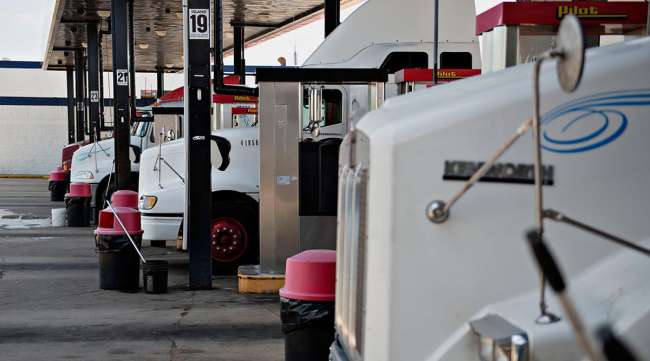Senior Reporter
Diesel Falls 1.5¢ to $3.064 Per Gallon

[Stay on top of transportation news: Get TTNews in your inbox.]
The U.S. average retail price of diesel fell 1.5 cents to $3.064 a gallon, the Department of Energy reported Jan. 13. Oil plunged more than $5 a barrel as fears of war with Iran faded.
Trucking’s main fuel costs 8.8 cents more than it did a year ago, when it was $2.976 a gallon, according to DOE.
Regional diesel prices fell in all areas except New England, where it rose 0.4 cent.
The U.S. average price of a gallon of gasoline fell 0.8 cent to $2.57 per gallon, according to DOE’s Energy Information Administration. It was 32.3 cents higher than a year earlier.
Average gasoline prices fell in all regions except the Central Atlantic and Midwest, where they climbed, respectively, 0.2 cent and 0.7 cent.
Meanwhile, the diesel market has largely shrugged off the IMO 2020 boost many were expecting, according to Bloomberg News. “Warm weather across the globe is partly to blame, along with recent downward revisions to oil demand growth forecasts,” said Steve Sawyer, director of refining at FGE.
IMO 2020 is a mandate from the International Maritime Organization that caps the sulfur content of marine fuel used by ocean-going vessels at 0.5% by weight compared with the previous 3.5% limit. It took effect Jan. 1. Vessels can comply by switching to very low-sulfur diesel fuel or installing scrubbers that remove sulfur from traditional bunker fuel.
Meanwhile, one fleet executive had some advice on best practices for smaller fleets for managing fuel expenses.
“We set up two transactions every 24 hours. We allow a 200-gallon per 24-hour tank limit. That has been pretty universal, even across the refrigerated lines that seem to be hovering right at that limit,” Garrett Bowers, CEO of Bowers Trucking, a 40-year-old carrier, told Transport Topics.
“It really allows for our drivers to be more conscious about when they stop for fuel as it concerns hours of service, as well as it safeguards the company, financially, against any kind of pirating of fuel or selling of fuel out from underneath your nose.”
The Ponca City, Okla., fleet has 52 trucks and operates flatbeds, dry and refrigerated vans, heavy-haul equipment and power only, and serves all 50 states and Canada. It has a logistics arm, too.
He said trailer alignment also is a big issue for his fleet.

“The trailer drag can really lead to added fuel use out there. So trailer alignment, shock absorbers, things like that all translate to better fuel economy,” Bowers said.
Bowers Trucking uses about 170,000 gallons of diesel a month, he said.
Meanwhile, domestic politics could roil the fuel market, the Oil Price Information Service noted.
“More than any other election, the 2020 presidential and congressional elections have the potential to create major uproar across all fossil fuels. The Trump administration has emphasized deregulation and has been loath to acknowledge, let alone propose solutions, to what many countries regard as an unfolding climate crisis,” according to the OPIS 2020 Market Outlook.
In related news, the Western States Trucking Association and San Diego-based P-Fleet announced they have established a cost-plus pricing program that is based on OPIS wholesale prices for all Commercial Fueling Network sites. CFN is a unit of Fleetcor, a business payments company. P-Fleet offers fleet fuel cards for businesses nationwide.
“We understand that fuel costs are one of your highest operating expenses. One of the services that we have been trying to improve for the members is a legitimate Western region fuel-savings program,” the Upland, Calif.-based association said in a release.
It will be “pushing out” information on the program in mid-February.
West Texas Intermediate crude futures on the New York Mercantile Exchange closed at $58.07 Jan. 13 compared with $63.27 per barrel Jan. 6.
“There is a continuing sense that the geopolitical risk from Iran has come down dramatically,” Phil Flynn, a senior market analyst at Price Futures Group Inc., told Bloomberg. “There is reduced risk to supply and that’s weighing on market sentiment.”
Inventories of distillate fuel — primarily ultra-low sulfur diesel used in transportation and to a lesser degree as heating oil — increased by 8.2 million barrels during the week ending Jan. 10 and are about 3% below the five-year average for this time of year, EIA reported.
Distillate fuel product supplied, an indication of demand, averaged 3.5 million barrels per day over the past four weeks, down by 6.9% from the same period last year, EIA said.
At 428.5 million barrels, U.S. crude oil inventories are at the five-year average for this time of year.
Want more news? Listen to today's daily briefing:




